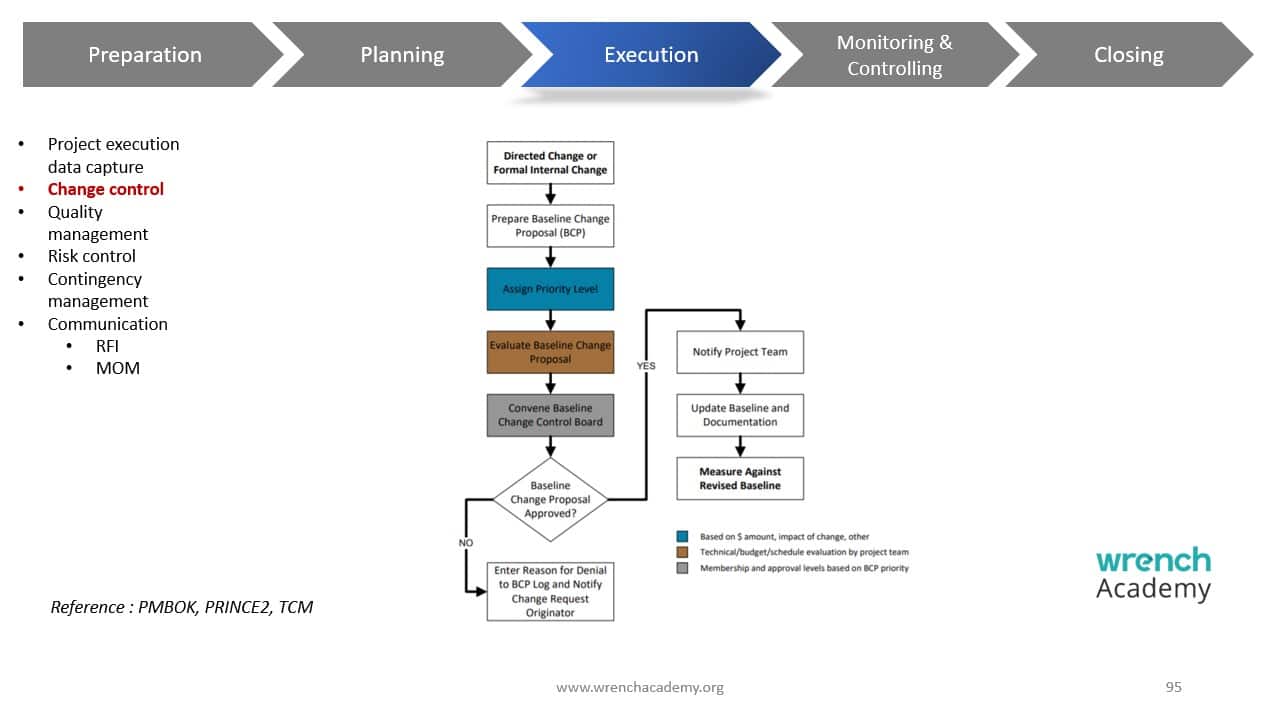Change Control
Change Control
Lesson Objective
To introduce the participants to the change management process
Effort required – 15 minutes
Lesson Introduction
Engineering and construction projects require several tasks to be carried out within pre-defined scope, quality, time and cost. These tasks are expedited in multiple stages including engineering design, tender evaluation, planning, contracting, execution and close-out.
Though most information is usually available at the beginning of a project, certain elements of such as wall dimensions, service route and equipment orientation may change according to requirements at site. In some rare instances, the client may even opt for a different design during execution. This is where change control (also known as change management) plays a crucial role in project management.
If the changes are not identified, recorded and notified to the respective stakeholder, the company executing the change will incur additional cost and may not meet milestone/ schedule dates. The client may also subsequently impose penalty which adds to the commercial burden on the engineering consultant/ contractor.

What is Change Control? The Chartered Institute of Building (CIOB) ‘Code of practice for project management’ (4th edition), defines change control as a process that ensures potential changes to the deliverables of a project or the sequence of work in a project, are recorded, evaluated, authorized and managed.
What causes Change?
Some of the most common causes of change are:
i. Inadequate design parameters
ii. Missing information in the contract documents;
iii. Differing site conditions;
iv. Regulatory changes;
v. Statutory changes and;
vi. Additional interface requirements;
Change Control Procedure
Some of the common procedures are provided below:
a) Identify the change/ deviation from original scope
Change/ deviation is usually identified at a working level. For example, in the case of an EPC contractor, the site engineer may not be able to install an equipment in a room due to small room size.
b) Explore whether mitigation is possible
The site engineer must explore all possibilities whether it is possible to install the equipment despite the room size constraint. His project manager may consult with equipment manufacture and check for alternate solutions to install the equipment within the constrains.
c) Notify the engineering consultant/ client
If mitigation is not possible, the contract administrator/ quantity surveyor/ project manager/ design manager must immediately raise a formal notification to the engineering consultant/ client. This must be done with a certain number of days as mentioned in the contract agreement. The notification must briefly explain the cause of change, mitigation efforts undertaken and possible effect. For example, if the equipment in not installed, then the facility cannot be used.
d) Submit detailed claim
Within certain number of days after notifying the engineer consultant/ client, a detailed claim may be submitted along with details on additional cost and time required to rectify the change.
e) Claim Evaluation
Within certain number of days after receiving the claim, client may engage a cost consultant to scrutinize the claim. The cost consultant may request the contractor for further details and clarifications. The contractor must provide all details for the cost consultant to conclude his evaluation of the claim.
f) Issuance of Change Order
Once the cost consultant has verified the claim and client contract administrator has ensured that the change/ deviation is outside the contractor’s scope, the client may issue a formal change order with instruction on cost & time.
g) Expedite the Change
Once the contractor receives the formal change order, he may proceed with procurement and execution of the work.
Conclusion
Changes are inevitable in construction projects, although the size, scope, and complexity of projects may differ from project to project. Changes are a major cause of project delay, cost overruns, defects, or even project failure. Hence a robust change management system is a critical component of the construction industry.

